J/133
Cruising or racing, performance comes first in J Boats' 43-footer
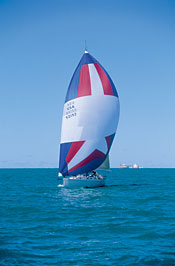 The cruiser comes before the racer, just look at the brochure." It was hard to tell if Rich Sterns of J Boats Midwest was joking or not as he tweaked the mainsheet. It was not hard to feel the new J/133s impressive acceleration. It was a seat of the pants sort of thing, no need to look at the speedo, the boat just heeled slightly and powered up. Sterns has the soft touch of a professional helmsman, which of course he was for many years before making a recent foray into the equally challenging world of selling boats. When I glanced at the B&G instruments mounted above the companionway, we were sailing impressively close to the wind, in less than 10 knots true, and cutting through the Lake Michigan chop at close to 8 knots. Sure the word "cruiser" might be placed on the left side of the slash before the word "racer" on the brochure, but like all Js, terrific performance is the 133's raison d'etre.
The cruiser comes before the racer, just look at the brochure." It was hard to tell if Rich Sterns of J Boats Midwest was joking or not as he tweaked the mainsheet. It was not hard to feel the new J/133s impressive acceleration. It was a seat of the pants sort of thing, no need to look at the speedo, the boat just heeled slightly and powered up. Sterns has the soft touch of a professional helmsman, which of course he was for many years before making a recent foray into the equally challenging world of selling boats. When I glanced at the B&G instruments mounted above the companionway, we were sailing impressively close to the wind, in less than 10 knots true, and cutting through the Lake Michigan chop at close to 8 knots. Sure the word "cruiser" might be placed on the left side of the slash before the word "racer" on the brochure, but like all Js, terrific performance is the 133's raison d'etre.
Although the 43-foot J/133 is squeezed between the 40-foot J/120 and the 48-foot J/145, it is more closely related to the J/109, the successful 35-footer that was introduced in 2002. Like its smaller sister, the J/133 combines an easy to handle rig that delivers consistently fast sailing with genuinely comfortable accommodations. The long waterline and relatively narrow beam results in an efficient hull shape that doesn't need to be over steered. When the boat is in the groove, you find yourself just nudging the wheel from time to time.
The details
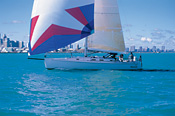 The sailplan calls for a manageable 105-percent roller-furling headsail, a retractable sprit for flying an asymmetric spinnaker without the need for crew and a full-batten main that can either drive the boat at hull speed or be used for nimble maneuvering around the marina. The folks at J Boats simply don't like motoring and believe that happiness is directly proportional to time spent under sail.
The sailplan calls for a manageable 105-percent roller-furling headsail, a retractable sprit for flying an asymmetric spinnaker without the need for crew and a full-batten main that can either drive the boat at hull speed or be used for nimble maneuvering around the marina. The folks at J Boats simply don't like motoring and believe that happiness is directly proportional to time spent under sail.
The J/133 hull and deck are molded by TPI Composites, using the patented SCRIMP system. This well-proven process places the entire laminate in a dry mold. A vacuum eliminates air voids and then just enough resin is infused through feed tubes to wet the laminate. The resulting balsa-cored hull is light, very strong and extremely durable. 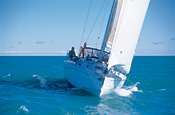
The hull-and-deck joint is bonded with aircraft-grade methacrylate adhesive, a completely chemical joint without the leak potential of mechanical fasteners. The main bulkhead is actually fiberglass, epoxied to the hull and deck, and unlike most veneered plywood bulkheads, it won't delaminate and also can absorb and flex with the unpredictable stresses of the sea. A molded structural grid, comprised of keel floors and longitudinal stringers, stiffens the hull and provides support for the mast step and engine bed.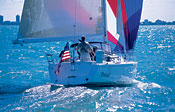 The antimony-reinforced foil shaped keel is externally fastened to a molded stub with stainless bolts. The standard draft is 7 feet, 6 inches, although a shoal-draft 6-foot, 3-inch keel is an option. The high-aspect rudder blade and stock are carbon fiber. I realize than many builders are using carbon fiber for stocks, and I understand the advantages of not mixing materials, still, I am wary of a carbon fiber rudder stock. High-quality bearings are essential to eliminate any wear on the stock. And there are plenty of boats out there cruising with this arrangement and no problems.
The antimony-reinforced foil shaped keel is externally fastened to a molded stub with stainless bolts. The standard draft is 7 feet, 6 inches, although a shoal-draft 6-foot, 3-inch keel is an option. The high-aspect rudder blade and stock are carbon fiber. I realize than many builders are using carbon fiber for stocks, and I understand the advantages of not mixing materials, still, I am wary of a carbon fiber rudder stock. High-quality bearings are essential to eliminate any wear on the stock. And there are plenty of boats out there cruising with this arrangement and no problems.
On deck
 The J/133 cockpit is designed for efficient sail handling yet it is deceptively comfortable. The cockpit seats and aft deck area offer nice perches to trim and steer from respectively. A Harken mainsheet traveler, complete with Black Magic series blocks, is mounted on the aft end of the seats, just forward of the helm. Although you have to climb back to the wheel, it is easy to control the main from the helm. The steering system is by Edson and a 60-inch Diamond series wheel with an elkhide grip is standard. Most steering is done from the side, where the visibility and feel are best.
The J/133 cockpit is designed for efficient sail handling yet it is deceptively comfortable. The cockpit seats and aft deck area offer nice perches to trim and steer from respectively. A Harken mainsheet traveler, complete with Black Magic series blocks, is mounted on the aft end of the seats, just forward of the helm. Although you have to climb back to the wheel, it is easy to control the main from the helm. The steering system is by Edson and a 60-inch Diamond series wheel with an elkhide grip is standard. Most steering is done from the side, where the visibility and feel are best.  Harken 56.2 STA are used for the primary winches with 48.2 STAs serving as secondaries and for the mainsheet and halyard winches. Reefing and furling lines are led aft making the J/133 one of the few performance boats that can be sailed by a couple, or even singlehanded. The halyards were not led aft, thank goodness. This is an inefficient place to hoist a sail from and also results in a mass of line in the cockpit and on the aft end of the house. A port locker is designed to carry a six-man liferaft and there are two decent-sized lazarettes. The propane locker to starboard is vented and drains overboard. The stern step flows artfully within the hull lines and includes a clever telescoping ladder.
Harken 56.2 STA are used for the primary winches with 48.2 STAs serving as secondaries and for the mainsheet and halyard winches. Reefing and furling lines are led aft making the J/133 one of the few performance boats that can be sailed by a couple, or even singlehanded. The halyards were not led aft, thank goodness. This is an inefficient place to hoist a sail from and also results in a mass of line in the cockpit and on the aft end of the house. A port locker is designed to carry a six-man liferaft and there are two decent-sized lazarettes. The propane locker to starboard is vented and drains overboard. The stern step flows artfully within the hull lines and includes a clever telescoping ladder.
The J/133 has a low-slung trunkhouse with stainless handrails and wide side decks. I really like the integral molded toerails forward of the mast and J Boats always does a terrific job on nonskid. Remember the brochure-this a cruiser-racer, and to back up that claim, the deck includes an external anchor locker, a standard dodger and provisions for a bimini top. And of course the retractable carbon fiber sprit is standard. I'm not sure if this is a cruising or racing feature. I do know that it makes handling an asymmetric spinnaker dramatically easier, and let's face it, A-sails are the reaching sails of both the future and the present.
The double-spreader mast is a custom designed auto-claved carbon fiber section from Hall Spars. The mast step is a custom epoxy piece bolted to a centerline longitudinal stringer. The boom is aluminum and a Hall QuikVang is standard. The standing rigging is Navtec continuous rod led to single pod chainplates. Although the rig is just a shade fractional there are no checkstays or runners, which really simplifies sail handling. An Antal mainsail track is standard and a Harken MKIII 2.0 furling system is standard issue on the forestay. Indeed, Harken gear is in evidence all over the boat, including the adjustable headsail car system that is led to the cockpit.
Down below
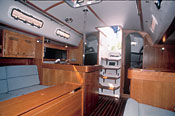 The J/133 offers two interior plans. The standard layout includes three private sleeping cabins, the optional arrangement includes a single aft cabin, a second head and the V-berth forward. The handsome interior is at once elegant, albeit in a no-nonsense New England fashion. The joinerwork is well executed and the finish is cherry with satin varnish. The 6-feet, 4 inches of headroom lends a feeling of spaciousness, and considering the limitations of a performance hull, designer Rod Johnstone does an excellent job of using the available space.
The J/133 offers two interior plans. The standard layout includes three private sleeping cabins, the optional arrangement includes a single aft cabin, a second head and the V-berth forward. The handsome interior is at once elegant, albeit in a no-nonsense New England fashion. The joinerwork is well executed and the finish is cherry with satin varnish. The 6-feet, 4 inches of headroom lends a feeling of spaciousness, and considering the limitations of a performance hull, designer Rod Johnstone does an excellent job of using the available space. 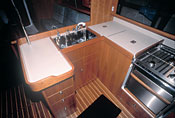 The forward cabin includes a generous V-berth, even with the sprit tube housing above, and there is a lot of storage underneath. A hanging locker, dressing seat and vanity are to port, with the dual access head to starboard. The instrument transducers are easy to check below a hatch in the sole. The head is not overly large, but how much time do you spend in there anyway? It has all the necessary features including a shower.
The forward cabin includes a generous V-berth, even with the sprit tube housing above, and there is a lot of storage underneath. A hanging locker, dressing seat and vanity are to port, with the dual access head to starboard. The instrument transducers are easy to check below a hatch in the sole. The head is not overly large, but how much time do you spend in there anyway? It has all the necessary features including a shower. 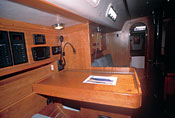 The saloon has settee berths port and starboard with storage behind and cabinets above with a small shelf between. Finding places to stow gear and provisions will be a challenge for any long-range cruising plans, though. The drop-leaf table has a center liquor cabinet. Halogen lighting is used throughout the boat and the ventilation is excellent with two hatches and nine opening portlights.
The saloon has settee berths port and starboard with storage behind and cabinets above with a small shelf between. Finding places to stow gear and provisions will be a challenge for any long-range cruising plans, though. The drop-leaf table has a center liquor cabinet. Halogen lighting is used throughout the boat and the ventilation is excellent with two hatches and nine opening portlights.
The U-shaped galley is on the small side although it includes double stainless sinks, a three-burner Force 10 cooker, a dry goods locker and reasonably sized icebox. Refrigeration is optional. The cook is well supported on either tack and husky fiddles will keep the ingredients on the counter. The nav station is opposite the galley and is one of the best features of the interior plan. With the advent of cockpit mounted plotters, many designers are quietly conspiring against traditional chart tables-I think its an outrage, or at least disappointing. The J/133 nav center can handle a real chart, not just a chart kit, has a well-supported seat and room for repeaters and books.
The aft cabins on the standard model are identical. They include double berths, full-length shelves above the bunks and hanging lockers. In the two-cabin model, the port cabin is replaced by a second head, and unless you need the privacy, this is the preferred arrangement.
A 54-horsepower, four-cylinder Yanmar diesel with a Saildrive SD 40 transmission and folding two-bladed prop is standard. I like that J has opted to make a Racor fuel filter standard as well as a 125-amp Power Max alternator. The standard house batteries are two AGM105-amp models, but I'd like to see more amperage. The 50-gallon aluminum fuel tank is housed under the port settee. The engine is well insulated: it's hard to hear it running in the cockpit.
Under sail
Back on deck, I took the helm. Every time I steer a big J I am impressed with the fingertip steering control. The sailplan makes sense. We were making good progress upwind with the North 105-percent jib and full main. Easing off the wind, Rich demonstrated how easy it is to set the sprit and hoist the chute. The Chicago waterfront hurried by as we sped toward Navy Pier flirting with 10 knots. We had to slow down to let the photo boat catch up. Johnstone understands that many sailing areas in North America have light winds in the summer and the generous rig on the 133 will drive the boat efficiently without big headsails. However, the same plan will cope with heavy conditions as well. This is the ethos of the boat, to be able to sail efficiently through a range of wind conditions without changing headsails and to be able to fly the asymmetrical chute without a lot of fuss, muss or extra crew.
The wind started to diminish as we jibed the chute and headed south. A snuffer is a key part of the spinnaker plan, and the ATN sleeve gobbled up the A-sail easily. Setting the jib we worked our way back into the harbor, short tacking without raising a sweat and sailing at 30 degrees apparent. The only reason we fired up the engine was so that I could say I steered the boat under power. Yes, the J/133 motors along nicely, touching 7 knots at 2,400 rpms, but I suspect it will take many years of sailing to rack up a lot of engine hours.
The J/133 is an impressive addition to the J Boats fleet. It's a lively performer with genuine cruising accommodations. However, the best feature of the J/133 is that it is an absolute pleasure to sail, and that, after all, is what a sailboat, be it a cruiser-racer or vise versa, is
all about.

Comments